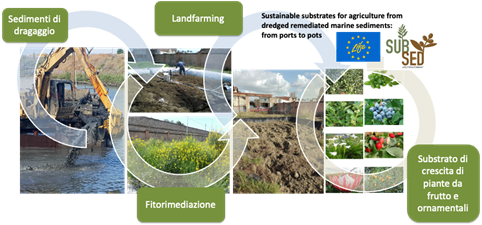
SubSed
End Date 30/09/2022
Email cristina.macci@cnr.it
The main objective of the LIFE SUBSED project was the production and use of sustainable substrates as alternatives to peat in the floriculture sector. Peat is a non-renewable resource, and its exploitation has a significant environmental impact, particularly on biodiversity and CO₂ emissions. LIFE SUBSED aimed to reduce this impact by developing alternative substrates derived from dredged sediments from the port of Livorno, recovered through remediation processes such as phytoremediation and landfarming.
The recovered sediments were mixed in different amounts with commercial products based on peat, coconut fiber, and wood fiber to best meet the needs of different crops and were applied to nursery production of ornamental plants (laurel), fruit trees (olive and lemon), as well as the cultivation of non-food crops (protea and calla) and food crops (basil, blueberry, and woodland strawberry).
The project involved agronomic tests in greenhouses in Italy at Pescia (Pistoia) and in Spain at San Javier (Murcia) and Orihuela (Alicante), comparing the new substrates with traditional ones. At the beginning and end of the cultivation substrate trials, parameters required by fertilizer regulations and related to agronomic quality and fertility of the substrate were evaluated. Destructive and non-destructive measurements were performed on the plants to evaluate productive performance in terms of yield, quality, and nutraceutical properties.
The collected data showed that these sediments can be a valuable resource and successfully used as a component of cultivation substrates in proportions ranging from 25% to 50%, depending on the species considered. Studies on food plants demonstrated that the use of remediated sediments does not present significant risks to human health. The LCA analysis highlighted a significant reduction in environmental impact due to the reduction of peatland exploitation and reduced logistics required to obtain the substrate.
Therefore, LIFE SUBSED represents a concrete example of a circular economy, demonstrating that it is possible to valorize waste materials by transforming them into useful resources for sustainable agriculture.

Media
| Web | Go to Website |

